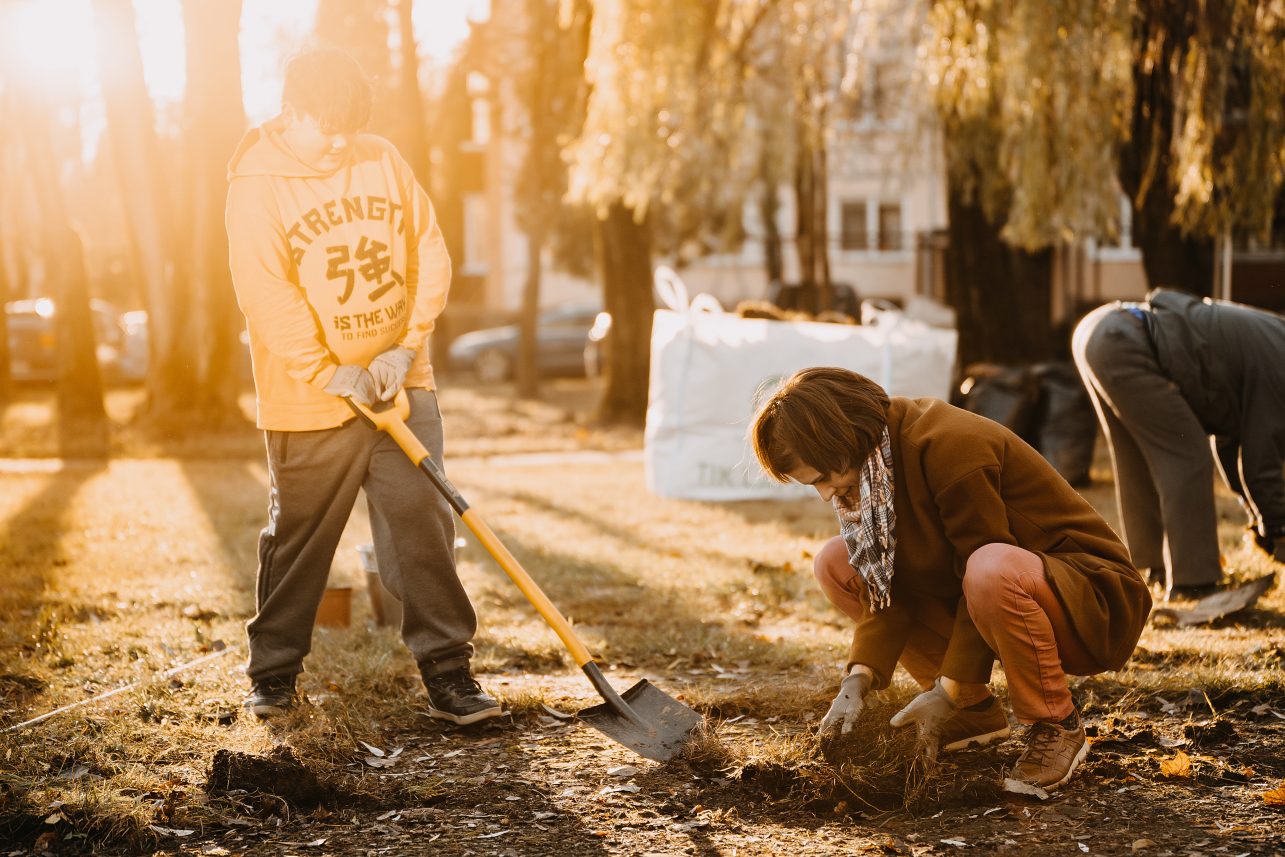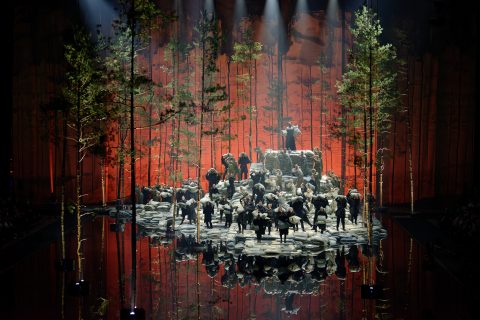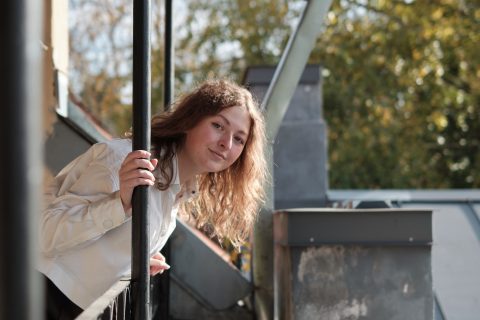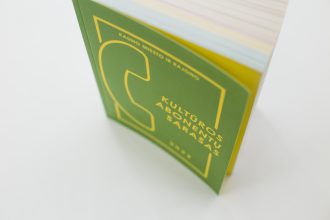Goda Pomeranceva lives in Lapės, Kaunas district, but considers the whole of Kaunas or even the whole world as her courtyard. Coordinator of the Kaunas 2022 community program Fluxus Labas! responsible for both the festival Culture to the Courtyards and the project Fluxus Labas! Kiemas, joined the team two years ago. She previously lived in the Netherlands, worked as an architect, and created major strategic projects with her colleagues, for example, planning a city in Africa. “I think on a larger scale, I see the city in layers, and when I am walking, I always look around and think of what could be improved and changed.”
Therefore, all the courtyards of Kaunas are equally dear to Goda, she knows their communities as well as the issues they face very well. She thinks that many of those problems can be solved more globally but her current work allows her to look at everything from below. In her daily activities, she combines both the skills of an architect and her interest in talking and listening to people.

How did you start working with courtyards? Did you just decide to walk around and see what you could suggest or was there an open call to people who have courtyards and want to have something interesting in them?
Fluxus Labas! Kiemas project consists of three parts. Community’s initiative is very important; I need an active individual or group of people. We cannot just bring an idea to a courtyard where no one is interested in any sort of change. So, all the courtyards are selected through an open call process. Then, a very important component is the artist or other professional in their field. As coordinators and facilitators of the Kaunas 2022 program, we combine those things and manage the finances of the project. All three parties try to figure out what the issue of the courtyard is. Most communities already know what they want when they apply. For example, to make friends, be more hospitable, get to know each other, or they worry that they have no space to gather in the courtyard. We try to encourage the residents to solve not only infrastructural, but also social and cultural problems. We come, we offer ideas, we discuss.
Although working with communities in Lithuania is a very new phenomenon, it should become commonplace.
Just yesterday I was in a courtyard meeting, where we, together with the residents and artists tried to come up with stories for a mural. Two artists and the courtyard residents gathered at the table, and I performed the role of a moderator. We were trying to establish what kind of people live in the courtyard, what they hide in their sheds, what their favorite spots in their apartments are and what do they like to do in them. The stories, memories and habits expressed during the meeting will help the artists to create sketches of the wall drawing.
How could Kaunas courtyards be grouped? Žaliakalnis’ courtyards with its more privately owned houses or buildings with several apartments, are very different from the ones surrounded by apartment blocks in microdistricts.
If you were to ask the residents of apartment blocks where their yard is, they would say that it is in front of the stairwell, the space they see after they exit the building. The courtyard ends with other buildings or trees. Or it is the area where they walk their dogs. Yesterday, I talked to a manager of one the block of flats and she defined her courtyard a bit differently. For her, the yard ends with the plot’s boundary. The manager told me that she and the neighbors had recently formed the plot, added some more land and installed a playground. In the near future, they are planning to fence the plot and mark its boundary according to the law. Although the residents of the surrounding apartment buildings believe that this is also their yard. And suddenly – no more! So, whoever forms the plot first, will be able to fence it first. If we all start building fences, there will be no more common yard where a community from different buildings meets. There will be no place for children to play together. The courtyard will be filled with fences, which, like barriers will prevent movement on foot in the quarters of apartment blocks. So, there is a great lack of dialogue here between the residents of the apartment blocks and between the community and professionals, who could advise or answer questions. Although working with communities in Lithuania is a very new phenomenon, it should become commonplace. Urbanists, architects, sociologists could be among the people in the courtyards helping them to discover their yard’s identity, strengths and weaknesses as well as starting talks about boundaries and defining them, the meaning of their courtyard, involving the community of the specific place in the decision-making process. Of course, external interventions are only possible when the community is open and willing to change, when it accepts a different opinion and professional advice.
It is obvious that there is a big and widely discussed problem in the courtyards of Kaunas apartment blocks and it is: cars. When the city was planned, large streets were built, but parking lots were not considered, perhaps because there were fewer cars at the time, but now, the courtyard spaces seem to belong to cars. People want tidy, green, comfortable courtyards that would also accommodate cars. But all this cannot fit in one yard. It seems that without outside help it will be difficult to solve this issue. And while cars are the predominant topic, it is very difficult to discuss cultural spaces or courtyard festivals.
The same can be said about the Old Town and the New Town. Cars have occupied those inner block spaces, but we as observers of the situation cannot offer a solution or a program from above; it is important to sit down with the residents and decide together what that yard should be. Maybe the residents will bring themselves to get rid of the cars and realize that they can walk ten minutes to their home and will be able to see their courtyard as a kind of oasis. But it all has to start with a dialogue.

Hasn’t anyone sold a car inspired by Fluxus Labas! yet?
Probably not yet, but it is a longer process. Maybe now that taxes are rising, they will sell.
Are there parts of the city that have more issues compared to other areas?
I could not single out one area. I could only say that where there are fewer apartments, there are fewer cars. The denser areas have more issues. The districts of Kaunas city are very diverse. The alienation, insecurity, lack of communal spaces, and poor diversity of functional areas in those elderships dominated by apartment blocks, where common spaces and courtyards belong to the municipality, could be solved by community facilitators, kind of social/cultural workers, who would become mediators between legislators and residents. Comparing parts of Kaunas, I see differences only between the attitudes of the population towards their environment. In those parts of Kaunas where the plots belong to the residents, the initiative, the desire for change and involvement is higher. In apartment block districts, the residents do not dare to initiate activities or projects, they find it difficult to go out to the courtyard or join cultural activities taking place there, they do not feel like their courtyard belongs to them and they are waiting for outside help. Although, from time to time, some active residents appear, who organize meetings, plant little flower gardens and try to get to know their neighbors.
Do you have to listen to complaints that are not addressed to you?
Oh, yes, I really do get to listen to complaints, comments, to take part from the inside, to see the lives of the block apartment residents through their eyes. One of such memorable projects took place in Dainava. Together with the community and the landscape architect, we decided to turn the yard into a green oasis, plant various plants, bushes, trees and build benches and a terrace. In order to do that, it was necessary to get the consent of the majority of the residents of four block apartments. Although the land belongs to the municipality, we had to ask the people living closest to it. I had to visit all of the apartments, some of them even several times. And mind you, one building has 90 of them. I had no such experience before. Collecting these signatures reminded me of watching many short films. Each apartment with its own story, history, beginning and end, one or more characters – I actually saw how the people of Kaunas live. Some are still angry, others are accusatory, some are already apathetic but there are also some optimists, who want to contribute to change, yet some residents no longer want anything. Some meetings ended with a cup of tea, but there were others that made me wonder if I knew the phone number of the ambulance. Some residents have alcohol problems, others are raising children and don’t know anybody; I met strong men, who were repairing apartments after the passing of its elderly residents… Each resident has a unique story. And with a smile, I was optimistically standing at the door of their apartment talking about the neighbor who got into the project, about planting new plants, organizing a meeting space, the green oasis, the communal involvement in planting various shrubs and plants, and the ways to fund the project.
Finally, we collected the signatures and waited for people to get together to help plant things. Fifteen, perhaps twenty residents, gathered from all the apartments I visited in two days. Certainly not a lot because there are over a few thousand residents in the surrounding apartment blocks. It just goes to show that working with people and building a community is an ongoing, long-term process, especially in courtyards, where the residents are not inclined to change their environment because they don’t feel like they own it. I didn’t feel like my courtyard belonged to me either, when more than 10 years ago I lived in an apartment block on Šiaurės Avenue. I thought I only owned the area that ends at the door of my apartment, well, maybe a staircase because I had to wash it (that one floor) based on the schedule. And that’s it. Something beyond that was no longer my space.
Perhaps other neighbors saw those 15, who decided to come out, through their windows and decided to join them?
Not then, but in a couple of weeks with Austėja Bliumkytė-Padgurskienė and Linas Ūsase we will organize a second gathering in the same courtyard in Dainava, so, I hope that people will remember that they are welcome, will believe in the idea of a green oasis of the courtyard and come out to spend some time together. I remember when I was standing at the people’s doors and listening to their stories, it seemed as if they were tired of promises and talks about plans. I hope that the first get together showed that we are much more than empty promises. Step by step, we are truly working to achieve a visible result, and everyone can contribute to change. The intended result was achieved: the plants were planted, the lot was cleared, the space for the terrace was prepared. People played basketball and teenagers shared memories with the senior citizens. Now, we will invite everyone to meet again. And in the fall, we’ll plant more flowers and then celebrate. And let’s not forget the upcoming Culture to the Courtyards event. I hope that concerts will motivate people to leave their flats.
Probably one of my main goals now is to talk to everyone personally, hear them out and tell them what we do. Next step is for the person to at least try to get out into the yard. No need to contribute to activities, only to get out there. Maybe bring out a chair. That would be the third step. And then listen to a concert while sitting on that chair. This is already a lot. If 30 – 50 people took a chair out then they would already be able to solve issues together because they are already willing to do something: to get out, to open up. But this is a process. This is its aim. We must be there where help is needed; to push, to help the building managers or communities to use the available tools. There are many wonderful courtyards, from which we can learn and get inspired by, but Fluxus Labas! program is for those, who need a bit of a push.
What would you consider the best acknowledgement of your work?
While restoring the benches next to one of the apartment blocks with architect Algimantas Grigas, we noticed an issue. One elderly resident of the building, who manages his two square meters of space under the balcony (after all, the space under the balcony belongs to the person, whose balcony it is), plants various plants there, paints little metal fences, is not very well liked by other neighbors because he does that without consulting others. After a week of neighborly workshops, discussions, talks and communal work in the courtyard, Algimantas was able to reconcile with the neighbors, sit them all at one table and solve that long-standing problem. Eventually, the outcast considered the remarks made by his neighbors, pruned down thujas, repainted the fences and even made a toast at the table rejoicing that now more people started caring about the environment. It sounds like a small thing, but to me it means a lot. Later, when I was collecting the signatures from people about their consent to planting things in the courtyard, I introduced two neighbors. When I rang one doorbell, I heard an elderly woman’s voice, which distrustfully informed me that she will not be opening the door because her daughter had told her not to let in strangers. I said goodbye to the lady and went on to talk about the idea of a green courtyard to another neighbor nearby. A few minutes later, the older lady peeked into the staircase because she overheard us talking about the communal tidying up. This is how the first meeting of the neighbors happened, they got acquainted and continued talking after I left. I was very happy that the elderly lady made a connection and now will be able to turn to the person closest to her for help.

It also happens that during or after the project, one elderly resident passes away. I keep remembering them, after all, we communicated, they were happy, smiling… and now they are gone. It seems that we gave them an opportunity to be a part of the community for a little while and they – through their memories and stories – gave us a chance to travel in time and get to know the environment, the values, the way of life. I find it truly special.
Or… two weeks ago in Šiaurės Avenue, I invited two neighbors to the courtyard of their block apartments to just have some tea. We brought out four chairs, some cookies, teacups and had a talk. After a few minutes, the neighbor calls her son and says, “Bring us the kettle.” He didn’t really understand what his mother wanted from him, where to bring that kettle because he had never taken a kettle to the courtyard. After he emerged from the building, he walked back and forth in confusion, not realizing where his mother was. When he saw us and approached us and gave her the kettle, you could see how surprised he was.
And this week, the same teenager was already sitting with us at a table in his own courtyard. We were drinking tea again and listening to stories. Maybe it is difficult to wrap your mind around it, but it is indeed possible to have tea in the courtyard of a block apartment. All you need is two chairs, several teacups and the conversation begins.




